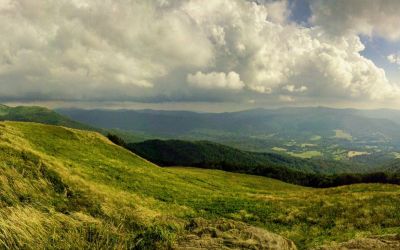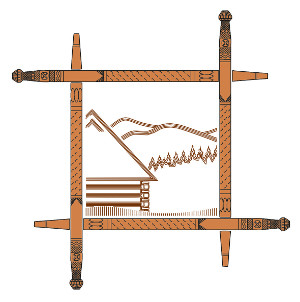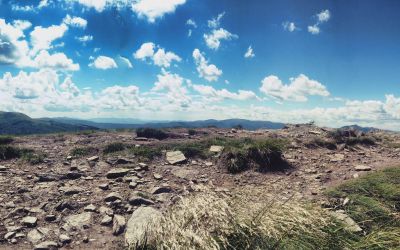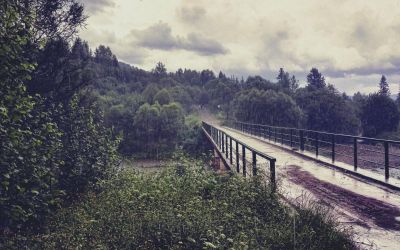
The south-eastern part of the Polish Carpathian Mountains is highly transformed by human activity, both agricultural and forest exploitation. The result is a cultural landscape consisting of villages in the land of valleys with their cultivated fields, forests on the slopes and mountain meadows with the characteristics of alpine meadows. After the displacement of the population, many ecosystems were partially renaturalised, afforestation increased significantly (85%) and population density remains at a very low level (less than 10 people per km2). Nature recovers agricultural areas abandoned by people as well as protected forests, but there are still visible traces imprinted by many centuries of human agriculture. The natural and cultural landscapes interlace with each other. The result is a unique, extremely biodiverse environment with a unique character in Europe.
The Bieszczady Mountains are particularly popular among tourists. Their uniqueness is determined by their secondary wilderness. Biodiversity results from the geographical location, at the junction of eastern and western Carpathian influences. Due to the large forested areas, it is the refuge of many large mammals, both herbivorous with the European bison at the forefront and predators such as the wolf, brown bear, lynx and wildcat. There are also many predatory birds, because they find convenient places for nesting here and there is a possibility of feeding in open grassy areas. It is so due to the fact that some forests have a primeval forest character with a large number of old trees and decaying trunks, and there are many floral plants in the meadows, the entomofauna is also very rich here.
The layer arrangement of vegetation is also peculiar to the Bieszczady Mountains. There are only three layers here: the foothills layer (about 500-550 m above sea level), the lower mountain layer (1100-1250 m above sea level), the Carpathian beech, occupies the largest area and the mountain pasture layer (subalpine meadows), where fragments of alpine vegetation can be found in the rock outcrops. The Bieszczady peaks are not very high, so the lack of the rock tower layer is justified.
The Bieszczady National Park (29,200 ha) was established to protect the Polish part of the Eastern Carpathian Mountains. After abandoning grazing on a large scale in the Park, the processes of renaturalisation of non-forest ecosystems take place. According to numerous scientific studies, they lead to the disappearance of biodiversity. Mowing and shrub removing of a part of meadow areas prevents this to some extent. However, extensive grazing works better, which is why three areas in the Park are used for grazing in the so-called Valley Land, i.e. in the area of former villages. There are shepherds’ huts on the mountain pastures of grazing cows and sheep, where tourists can watch the process of making cheese and buy it. Access to the huts is good and in fact it does not require walking off the trails.
The vast majority of the area of the Bieszczady National Park is covered by forests, only 9% are non-forest areas, including mountain pastures and subalpine grasslands existing above the forest level. And they determine the specificity of this Park. The mountain pastures were created naturally, but pasture use, which has existed here in a significant way since the turn of the fifteenth and sixteenth century, increased their area and influenced the species composition of plant groups.
Of course, farming developed also in the valleys, where new villages were established on the cleared areas and where the majority of cultivated areas were meadows and pastures. Since the time when villages were established based on the Wallachian settlement, human pressure on the environment has been subject to considerable fluctuations. The villages grew, but also periodically almost depopulated, often as a result of attacks and robberies, migration and climate changes. Social relations and the course of borders changed. All this had an impact on the lives of the inhabitants, and thus on the landscape in which they lived. However, agriculture, especially shepherding, was still the most important area of the region's economy. Because of its mountainous location, weak, heavy soils and slopes made only pastoral farming successful. Therefore, new mountain meadows and pastures were created and mountain pastures were expanding.
Shepherd's use of the mountain pastures, which lasted for about five hundred years, significantly changed the species composition and structure of natural plant communities. Intensive grazing and cutting down of bushes led to lowering the forest boundary, spreading of Nardus grasslands, and at the same time high mountain grasslands, peatbogs and rock vegetation were degraded. About 80 years after the disappearance of shepherding, studies were carried out, during which a significant increase in phytocentric diversity of the mountain pastures was found. Subalpine, rocky, alpine grasslands and other communities, including shrubby ones, are reproduced. At the same time, Nardus grasslands have almost completely disappeared.
To the west of the Bieszczady Mountains there is Low Beskid, a wide range of relatively small mountains, the base of which is the Carpathian flysch, i.e. sedimentary rocks. It lies partly in Poland (the highest Polish peak is Lackowa 997 m above sea level) and partly in Slovakia (Busov 1002 m above sea level).
The nature of the Low Beskids has a transitional character between the Eastern and Western Carpathian Mountains. Due to the lack of oaks, spruces, black alder, white and black poplar and a small amount of hornbeam, this area is classified as a mountainous oak-free district.
There are only two layers here: the foothills (up to 500 m above sea level) and the lower layer. The lower part of the region is mostly covered with forests, a characteristic community of beech and fir forests (Fagetum carpaticum). Larger forest complexes of well-preserved Carpathian beechwood can be found on the slopes of Magura Wątkowska, the northern slope of Magura Małastowska, and on the slopes of the Wołosiec valley.
Up to 700 m above sea level, fir is quite common, sometimes forming solid stands. Above it gradually gives way to beech trees. In the highest, top zones there are almost pure beech forests. The most fertile is the Carpathian beech forest, smaller areas are occupied by the acid beech forest. Small areas, mainly on steep slopes, are occupied by sycamore, relatively rare in the Carpathian Mountains. There are few oak-hornbeam forests, sometimes with the participation of lime trees, mainly on the slopes or along streams, in the lower parts of the valleys. Among the lower layer forests there are also former pastures, mainly in the form of grasslands with the character of poor Nardus grasslands or moorland. Gradually they are overgrown with juniper, wild rose, blackthorn, alder and pine.
The first layer of the foothills is mostly occupied by cultivated fields, meadows and pastures, a small part of which are patches of forests mixed with fir, birch and aspen. Forests occur mainly on steep slopes. Where the slope is small, the forest boundary has been shifted upwards as a result of human activity. A characteristic feature of the Low Beskids is the fact that a large part of agricultural land is abandoned and gradually renaturalized. The main process is gradual overgrowing of trees and shrubs. The first ones to appear in the abandoned fields and pastures are birches, pines, grey alder and junipers.
In the centre of the Low Beskids there is the Magurski National Park, in its southern part the surrounding zone of the Park is the Jaśliski Landscape Park. A significant part of the Beskids is protected according to the principles of Nature 2000. Several reserves have been defined here as well.
The Magurski National Park (an area of 19439 ha) is dominated by forest ecosystems (18531 ha). The spring area of Jasiołka and Wisłoka is protected by the Jaśliska Landscape Park. A characteristic element of the park are meadow and pasture complexes of former villages: Jasiel ("Źródliska Jasiołki” reserve), Czeremcha and Lipowiec.
Many species of large predatory birds such as front eagles, lesser spotted eagles and eagle owls nest in protected areas. Forestless areas are an important feeding ground for them.
The man appeared in the area of today's Low Beskids in the Neolithic, but its impact on the environment was marginal. More significant environmental changes began in the 14th century, when the settlement began here. The initial stage of settlement of the Low Beskids, until the 18th century, was connected mainly with the deforestation of river valleys, the enlargement of forest glades turned into pastures and the raising of the lower forest border. Since the 19th century, as the population grew, pressure on the environment increased, fragmentation of forests began, lower pastures disappeared for the benefit of arable land, and at the same time higher pastures, often on the slopes, were poor and turned into Nardus grasslands and moorlands. The displacement of the population after World War II resulted in the sudden abandonment of agricultural and, for a certain period of time, even forest agriculture, which, of course, resulted in significant changes in nature. The region lost more than half of its population. Some villages were completely depopulated and people never returned here, and the spaces, once densely populated valleys remained completely empty. This, of course, had its consequences in terms of changing the structure of land use. Grass vegetation has overgrown the former arable fields, the forest has entered into the former meadows and pastures mostly as a result of natural pioneer species, resulting in a transitional forest structure with birches, pines, alders and junipers, in some places supplemented with spruce and larch plantings. The forest areas increased significantly, and in some places the lower forest border decreased.
















